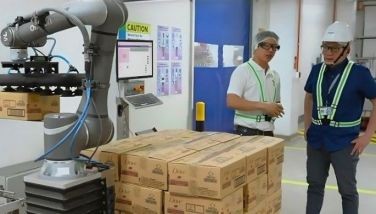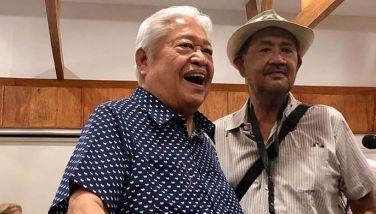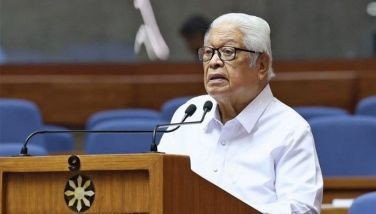Keeping healthy the state of healthcare workers

The state of the nation is said to be best reflected in the health situation of its people. So it was with cautious relief that President Ferdinand “Bongbong” Marcos Jr. (PBBM) enumerated some of the government priority programs at the State of the Nation Address (SONA) last Monday. In fact, PBBM literally cited the priority programs of the government for the country’s health sector. In his one-hour, 30-minute-long SONA, PBBM highlighted also the accomplishments in other key sectors of the Filipino nation from day one of his administration.
The SONA marks the traditional joint opening sessions of both chambers of Congress. PBBM delivered his SONA at the third and last regular session of the 19th Congress at the Batasan Pambansa in Quezon City. This was the third SONA for PBBM as he enters the middle of his six-year term at Malacañang Palace.
As a testament of his administration’s priority concern for the health sector, PBBM singled out the project of the University of the Philippines-Philippine General Hospital to construct a specialty medical center for cancer treatment. The Chief Executive identified this as the “first” under the Public-Private-Partnership (PPP) project carried out under his administration. PBBM, however, acknowledged the dire shortage of nurses, doctors and other health care workers (HCWs) in the government and public health/medical centers. But the same problem of lack of medical personnel also cripples even the private hospitals.
During a Malacañang Palace press briefing in May, Health Secretary Teodoro Herbosa declared the Philippines needs 190,000 HCWs to fill gaps in our country’s health care system. However, if we genuinely want our HCWs to stay, designated decision-makers and agencies must be able to address basic issues like the timely distribution of allowances.
During the height of the COVID-19 pandemic, former president Rodrigo Duterte signed Republic Act (RA) 11712 granting benefits and allowances for health workers during public health emergencies. Two years and a new administration later, we finally heard public reassurances from the Department of Health (DOH). From the latest official pronouncements, the DOH may finally settle the 5,039,926 unpaid Health Emergency Allowance (HEA) and the 4,283 COVID-19 sickness and death claims of eligible health care workers due them from RA 11712.
Oddly enough, the two-year wait appears to be a blessing, as the Department of Budget and Management (DBM) is releasing this P27.453 billion worth of allowance earlier than initially planned. DOH originally slated the HEA disbursement for the 2025 budget as per spokesman Alberto Domingo. But PBBM indicated there was no need to wait until then.
The DOH has made earnest attempts to allocate this budgetary support for health care workers. In fact, it included the advancement and protection of health workers’ rights and wellbeing in its National Objectives for Health, and its Human Resource Development Bureau is currently implementing the National Human Resources for Health Master Plan (NHRHMP) 2020-2040 to manage the health care workforce in line with the Universal Health Care Law. However, with the persistence of bureaucratic obstacles such as the long overdue release of HEA, it is no surprise that health workers become disenchanted with job prospects in the country.
Commission on Higher Education (CHED) Chairman Prospero “Popoy” de Vera III, in a recent media interview, gave a bleak picture of our country’s nursing profession.
“For nurses, 51 percent of all registered nurses are practicing their professions overseas. So only 49 percent are left here, not all are nurses anymore,” he said. “Out of the 49 percent, about 25 percent are in hospitals. The rest are in call centers.”
These numbers give us a grim picture: our health care support system is hemorrhaging. Actually, this situation has been going on for quite a long while already. This is not news. Last year, DOH officer-in-charge Maria Rosario Vergeire already referred to the emigration of nurses as a “bleeding” that needs to be stopped “as soon as we can.” If we go further back, the brain drain from the Philippines has been a major problem since the 1960s. Over five decades later, we are still faced with the same pervasive issue.
The DOH has expressed its concerns on how the shortage is affecting the country’s health goal to be among the healthiest in Asia by 2040.
This prompts the need to confront the question that has long been asked but remains unanswered. What new solutions can be done to keep our health care professionals satisfied? Not only should current approaches be re-examined, but also the institutions accountable for these solutions and how they will collaborate. While there is talk of a “whole-of-society” approach to health care, the operational specifics remain unclear.
In response, the Philippine Business for Education (PBEd) and Unilab Foundation (ULF) convened over 120 health experts, leaders, advocates and students at the Horizons of Healthcare Forum in April to foster dialogue about shaping the future of the Philippine Human Resources for Health. Naturally, health care worker shortage was a primary focus in its discussions on current health care challenges. Talks on recommendations revealed a common denominator shared by speakers and participants: the need for multi-sectoral collaboration.
In that private-sector organized forum, Dr. Minguita Padilla, technical advisor of ULF’s Health Sector Skills Council (HSSC) project, suggested that the Philippines should look into Australia’s Jobs and Skills Councils (JSCs) as a model for enhancing its health care sector and emphasized the importance of involving all stakeholders – government, private sector, academia and regulatory bodies – to effectively improve job security, wages, compensation, upskilling and adaptability to evolving employment conditions. The JSC model in Australia takes on that role, introduced in the same forum by Australian Healthcare and Hospitals Association executive director Dr. Rebecca Haddock, as a benchmark for the Philippines.
Such a solution and its potential synergy with the current efforts of the DOH merits exploration. Its novelty presents opportunities worth looking into.
Our country’s human resources are the lifeblood of Philippine health care. If we do not immediately focus our efforts on manpower assessment and collective action, this critical bleed-out may never end with the current state of health care workers in our country.
- Latest
- Trending





























